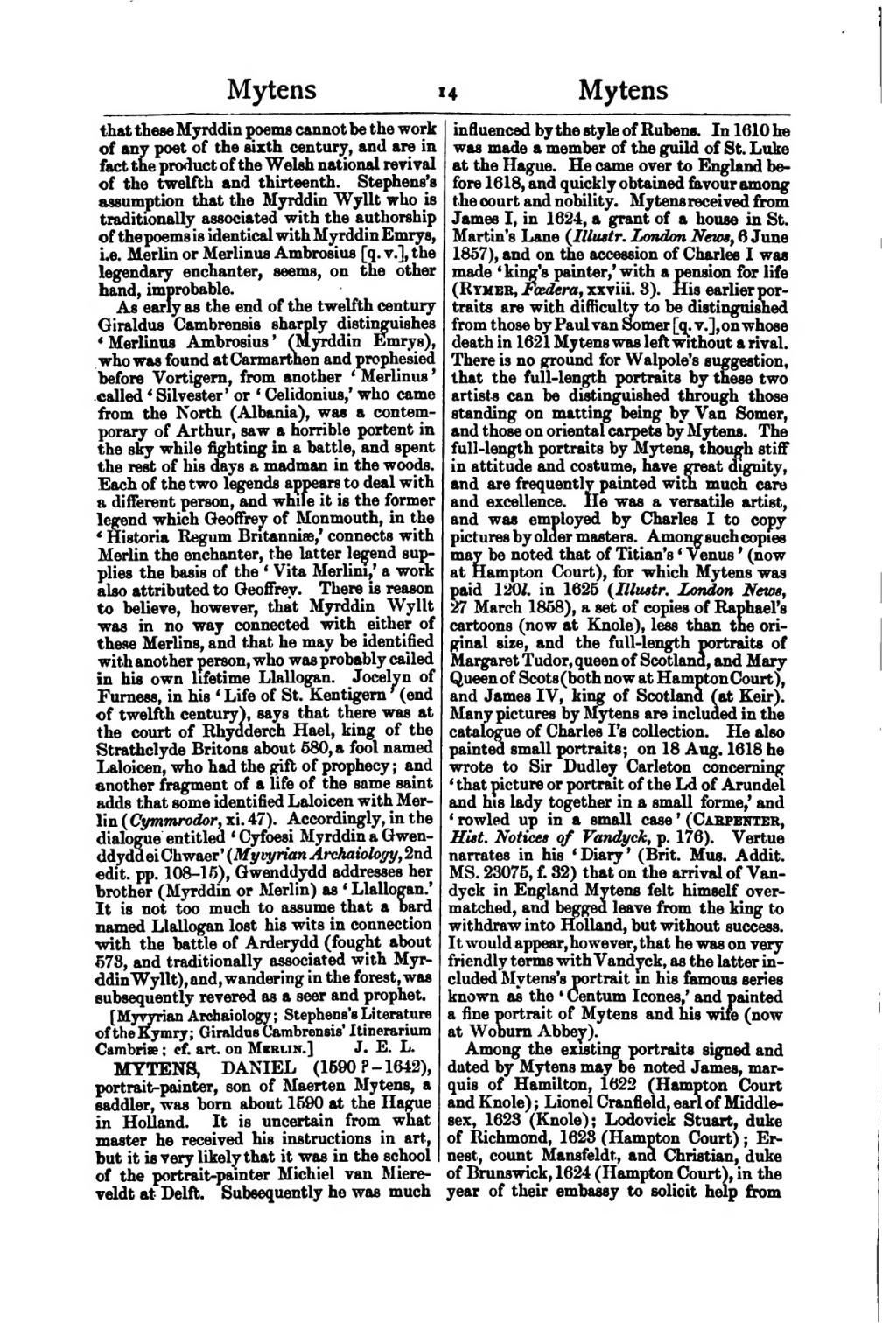that these Myrddin poems cannot be the work of any poet of the sixth century, and are in fact the product of the Welsh national revival of the twelfth and thirteenth. Stephens's assumption that the Myrddin Wyllt who is traditionally associated with the authorship of the poems is identical with Myrddin Emrys, i.e. Merlin or Merlinus Ambrosius [q. v.], the legendary enchanter, seems, on the other hand, improbable.
As early as the end of the twelfth century Giraldus Cambrensis sharply distinguishes ‘Merlinus Ambrosius’ (Myrddin Emrys), who was found at Carmarthen and prophesied before Vortigern, from another ‘Merlinus’ called ‘Silvester’ or ‘Celidonius,’ who came from the North (Albania), was a contemporary of Arthur, saw a horrible portent in the sky while fighting in a battle, and spent the rest of his days a madman in the woods. Each of the two legends appears to deal with a different person, and while it is the former legend which Geoffrey of Monmouth, in the ‘Historia Regum Britanniæ,’ connects with Merlin the enchanter, the latter legend supplies the basis of the ‘Vita Merlini,’ a work also attributed to Geoffrey. There is reason to believe, however, that Myrddin Wyllt was in no way connected with either of these Merlins, and that he may be identified with another person, who was probably called in his own lifetime Llallogan. Jocelyn of Furness, in his ‘Life of St. Kentigern’ (end of twelfth century), says that there was at the court of Rhydderch Hael, king of the Strathclyde Britons about 580, a fool named Laloicen, who had the gift of prophecy; and another fragment of a life of the same saint adds that some identified Laloicen with Merlin (Cymmrodor, xi. 47). Accordingly, in the dialogue entitled ‘Cyfoesi Myrddin a Gwenddydd ei Chwaer’ (Myvyrian Archaiology, 2nd edit. pp. 108–15), Gwenddydd addresses her brother (Myrddin or Merlin) as ‘Llallogan.’ It is not too much to assume that a bard named Llallogan lost his wits in connection with the battle of Arderydd (fought about 573, and traditionally associated with Myrddin Wyllt), and, wandering in the forest, was subsequently revered as a seer and prophet.
[Myvyrian Archaiology; Stephens's Literature of the Kymry; Giraldus Cambrensis' Itinerarium Cambriæ; cf. art. on Merlin.]
MYTENS, DANIEL (1590?–1642), portrait-painter, son of Maerten Mytens, a saddler, was born about 1590 at the Hague in Holland. It is uncertain from what master he received his instructions in art, but it is very likely that it was in the school of the portrait-painter Michiel van Miereveldt at Delft. Subsequently he was much influenced by the style of Rubens. In 1610 he was made a member of the guild of St. Luke at the Hague. He came over to England before 1618, and quickly obtained favour among the court and nobility. Mytens received from James I, in 1624, a grant of a house in St. Martin's Lane (Illustr. London News, 6 June 1857), and on the accession of Charles I was made ‘king's painter,’ with a pension for life (Rymer, Fœdera, xxviii. 3). His earlier portraits are with difficulty to be distinguished from those by Paul van Somer [q. v.], on whose death in 1621 Mytens was left without a rival. There is no ground for Walpole's suggestion, that the full-length portraits by these two artists can be distinguished through those standing on matting being by Van Somer, and those on oriental carpets by Mytens. The full-length portraits by Mytens, though stiff in attitude and costume, have great dignity, and are frequently painted with much care and excellence. He was a versatile artist, and was employed by Charles I to copy pictures by older masters. Among such copies may be noted that of Titian's ‘Venus’ (now at Hampton Court), for which Mytens was paid 120l. in 1625 (Illustr. London News, 27 March 1858), a set of copies of Raphael's cartoons (now at Knole), less than the original size, and the full-length portraits of Margaret Tudor, queen of Scotland, and Mary Queen of Scots (both now at Hampton Court), and James IV, king of Scotland (at Keir). Many pictures by Mytens are included in the catalogue of Charles I's collection. He also painted small portraits; on 18 Aug. 1618 he wrote to Sir Dudley Carleton concerning ‘that picture or portrait of the Ld of Arundel and his lady together in a small forme,’ and ‘rowled up in a small case’ (Carpenter, Hist. Notices of Vandyck, p. 176). Vertue narrates in his ‘Diary’ (Brit. Mus. Addit. MS. 23075, f. 32) that on the arrival of Vandyck in England Mytens felt himself overmatched, and begged leave from the king to withdraw into Holland, but without success. It would appear, however, that he was on very friendly terms with Vandyck, as the latter included Mytens's portrait in his famous series known as the ‘Centum Icones,’ and painted a fine portrait of Mytens and his wife (now at Woburn Abbey).
Among the existing portraits signed and dated by Mytens may be noted James, marquis of Hamilton, 1622 (Hampton Court and Knole); Lionel Cranfield, earl of Middlesex, 1623 (Knole); Lodovick Stuart, duke of Richmond, 1623 (Hampton Court); Ernest, count Mansfeldt, and Christian, duke of Brunswick, 1624 (Hampton Court), in the year of their embassy to solicit help from
